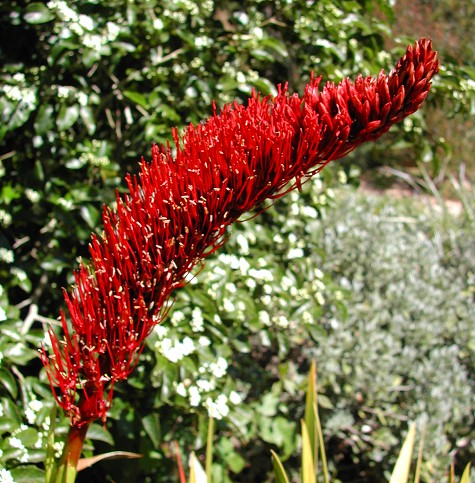Tips on growing Poor Knights Lily
Soil -- It seems to do best in a fast-draining, rocky medium, with regular watering. A typical soil mix is 1 part potting soil, 1 part pumice rock (or perlite, medium gravel, etc), and 1 part coarse horticultural sand. If you tend to over-water your plants, or if heavy rainfall is unavoidable, add extra pumice/perlite to your soil mix. If your potting mix doesn't contain nutrients (check the package) mix in some slow-release fertilizer that contains micronutrients (more on fertilizers down below). Use a pot about twice as wide as the one it's growing in, or slightly smaller. Avoid a dark colored pot, which can heat up the roots. In warmer climates, shade the pot to keep the roots cool, perhaps by placing the pot inside a larger pot made of clay, and fill the extra space with soil. When transplanting, avoid letting the soil ball break apart, which disturbs the roots. To keep the soil ball together, water it and wait 15 minutes for it to soak in. For a few weeks after transplanting, protect it from strong sunlight and temperature extremes, and give no liquid fertilizer. Climate -- Xeronema comes from a mild climate and is happiest between about 40 and 80° F (5-27°C) with cool nights (below 65°F / 18°C). It might be able to tolerate warmer conditions if nights are cool, but consistently hot conditions might stress it, especially if nights are warm. It can probably take a few hours at 28-30° F (-2°C) and maybe lower, but i strongly recommend protecting the plant from all frost. Watering - On the islands, they are bathed by light rainfall every couple of days. Some say that Xeronema is drought-tolerant, however my experience is that they can wilt or burn if the soil dries out, and this can stress the plant. So i recommend giving regular, light watering. It's hard to over-water the plant if grown in fast-draining soil and kept in a sunny spot. But avoid the combination of shade and soggy soil, as this can lead to rot. Sunlight -- They grow well with mostly sunny conditions, with some dappled sun or shade during warm afternoons. Along the cool Pacific coast they can handle full sun, but will require more frequent watering and fertilizing. Your plant was grown in filtered light, so acclimate it to stronger light gradually over a few weeks, watching for possible burning. Fertilizer - Xeronema grows slowly so it doesn't need much fertilizer. Moderate feedings about every 2-3 months should be enough, especially for a younger plant. You may use an all-purpose fertilizer that contains micronutrients. It's normal for an older leaf to occasionally turn yellow and die, but if it seems excessive, the soil may be too dry down in the root zone. If you're sure the roots have been moist enough, the plant may need more fertilizer (nitrogen). Some websites recommend giving the plant seawater a couple of times a year, but i haven't felt comfortable trying this. On the islands, they probably are sprayed with sea mist, although personally i would dilute any seawater you give your plant. I do recommend mixing some kelp powder into your soil, which you can buy at garden shops and online. Pot size -- It can flower in a large pot as well as in the ground, although they generally flower the soonest when the roots are cramped in a small pot (or cramped from other plants' roots). But i recommend giving your plant ample root space for at least a year, so it can grow up quickly. When it nears flowering-size, avoid repotting it, as this could delay flowering. If you must repot older plants, avoid disturbing the root system. Propagating - If your plant develops an offshoot with its own root system, you may separate it. Keep in mind that dividing a plant that is near flowering-size may delay flowering by a year or more. If you have any questions, feel free to contact me. Happy gardening! - Jeff Strange Wonderful Things
|
|||||||||


